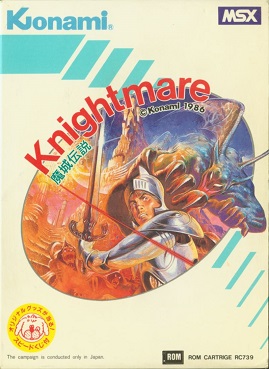
Knightmare is a 1986 vertically scrolling shooter video game developed and published by Konami for the MSX home computer. It was included in compilations for the MSX, PlayStation and Sega Saturn, followed by a port for mobile phones, and digital re-releases for the Virtual Console and Microsoft Windows. It is the first entry in the Knightmare trilogy. The game stars Popolon, a warrior who embarks on a quest to rescue the princess Aphrodite from the evil priest Hudnos. The player must fight waves of enemies while avoiding collision with their projectiles and obstacles along the way, and facing against bosses.

Demon's World is a 1989 run and gun arcade video game originally developed by Toaplan and published in Japan by Taito and in North America by Catalina Games. In the game, players assume the role of two ghost hunters to fight against several ghosts and monsters that were unleashed upon Earth by the titular demon king. Initially launched for the arcades, the title was then ported to the PC Engine Super CD-ROM² by NEC Avenue and published exclusively in Japan on 26 February 1993, featuring various additions and changes compared with the original release.
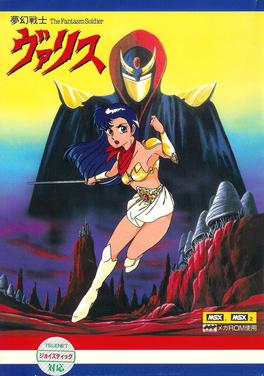
Valis: The Fantasm Soldier is a 1986 action-platform video game originally developed by Wolf Team and published by Telenet Japan for the MSX, PC-8801, X1, FM-7, and PC-9801 home computers. It is the first entry in the Valis series. It stars Yuko Asou, a Japanese teenage schoolgirl chosen as the Valis warrior and wielder of the mystical Valis sword to protect the Earth, the land of spirits, and the dream world Vecanti from demon lord Rogles. Through the journey, the player explores and search for items and power-ups, while fighting enemies and defeating bosses to increase Yuko's attributes.

Valis II is a 1989 action-platform video game originally developed by Laser Soft, published by Telenet Japan and NEC for the PC Engine CD-ROM²/TurboGrafx-CD. A home computer version was released for PC-8801, MSX2, PC-9801 and X68000. A super deformed-style remake was also released in 1992 for the Sega Mega Drive/Genesis. It is the second entry in the eponymous series. It stars Yuko Asou, a Japanese schoolgirl teenager chosen to become the Valis warrior by wielding the titular mystical sword, after defeating the demon lord Rogles. The dream world Vecanti fell under the rule of emperor Megas, whose hatred towards his brother Rogles and bloodthirsty tendencies seeks to wipe out traces of the former tyrant, including his supporters. Gameplay varies between each version but all share similar elements, as the player explores and search for items and power-ups, while fighting enemies and defeat bosses.
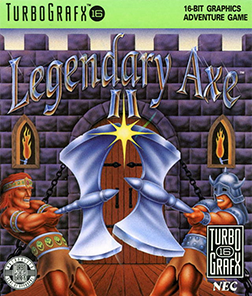
The Legendary Axe II is a horizontal platform video game created in 1990 by Victor Musical Industries. It is the follow-up to The Legendary Axe.
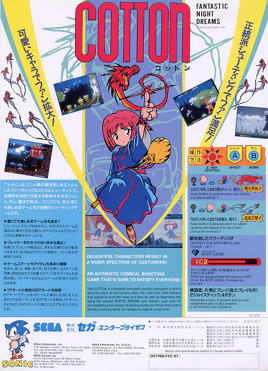
Cotton: Fantastic Night Dreams is a scrolling shooter video game developed by Success and originally released in Japanese arcades in 1991. The first installment in the Cotton series, players assume the role of the young witch Cotton who, alongside her fairy companion Silk, sets out on her broomstick on a quest to defeat several monsters and get her Willow candy. Its gameplay mainly consists of shooting mixed with role-playing game elements using a main two-button configuration. It ran on the Sega System 16 hardware.

Truxton II is a 1992 vertically scrolling shooter arcade video game originally developed and published by Toaplan in Japan and Europe. It is the sequel to Truxton, which was released earlier on arcades in 1988 and later ported to various platforms.

Cyber Core is a 1990 vertically scrolling shooter video game developed by Alfa System and published in Japan by Information Global Service (IGS) and in North America by NEC for the TurboGrafx-16. Set in the year 2269 where Earth has been overrun by an alien race known as Hyper Insects, the player controls a Chimera bio-fighter craft, piloted by the enforcer Rad Ralph in order to fend off the invaders and reclaim the planet. Similar to Dragon Spirit, Ralph has a projectile weapon for destroying air-based enemies and a bomb for destroying ground-based enemies.
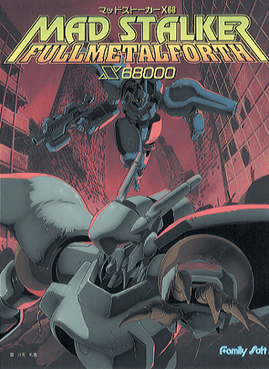
Mad Stalker: Full Metal Forth is a 1994 side-scrolling beat 'em up game developed by Fill-in-Cafe and published by Family Soft in Japan for the X68000. It is the fourth game to be created and released by both Fill-in-Cafe and Family Soft for the X68000 platform late into its commercial life span, after being discontinued in 1993.

Cho Ren Sha 68K is a 1995 vertically scrolling dōjin shoot 'em up video game developed and originally published by Koichi "Famibe No Yosshin" Yoshida at Comiket for the X68000. Taking place in a ring structure, players take control of the Zanki space fighter craft to fight against an assortment of enemies and bosses.
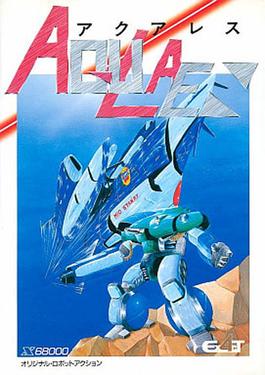
Aquales is an action role-playing run and gun video game developed and published by Exact exclusively for the X68000 in Japan on September 12, 1991. The second title to be created and released by Exact for the X68000 platform, the game takes place in the dystopian future of 2069 where the British Elias-Rits Investigative Unit ship went missing during a reconnaissance operation at the Kermadec Islands, as players assume the role of American pilot Fredric von Nyuya from the elite World-Ocean Development League squad taking control of a mecha in an attempt to unveil the truth behind the mysterious disappearance of the Elias-Rits embarkation during their operation. Its gameplay mainly consists of action and shooting mixed with mission-based exploration, as well as role-playing elements, using a main two-button configuration.
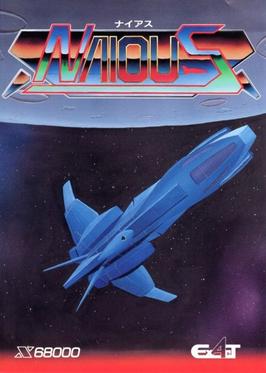
Naious is a scrolling shooter video game developed and published by Exact exclusively for the Sharp X68000 in Japan on October 26, 1990. It is both the first title to be created and released by Exact for the X68000 platform, as well as the first project produced by the company.

Dragon Ball Z: Idainaru Son Goku Densetsu is a 1994 fighting video game developed by BEC and published by Bandai for the PC Engine Super CD-ROM² add-on. Based upon Akira Toriyama's Dragon Ball franchise, it is a retelling of Goku's seven major battles over the course of the series up to the conclusion of the Cell Games saga. Idainaru Son Goku Densetsu was created by most of the same team at BEC that would go on to work on Dragon Ball Z: Idainaru Dragon Ball Densetsu. The game received generally positive reception from critics who reviewed it as an import title but criticism was geared towards its difficulty level.

Seirei Senshi Spriggan is a 1991 vertically scrolling shooter video game developed by Compile and published by Naxat Soft in Japan for the PC Engine CD-ROM². In the game, the player assume control of Jega and Rikart piloting the Spriggan in order to protect their country from the Buraizubara empire.

Rayxanber II is a 1991 horizontally scrolling shooter video game developed and published by Data West for the PC Engine CD-ROM². It is the sequel to Rayxanber, which was released earlier in 1990 for the FM Towns. In the game, the player assumes the role of a fighter pilot controlling a space craft to protect Earth against an alien invasion led by the returning Zoul Empire. The title was created by Team 50, a group within Data West that previously worked on the first entry for FM Towns. The music was scored by Yasuhito Saito, who composed for the original entry and also worked on titles such as Layla and The 4th Unit series.
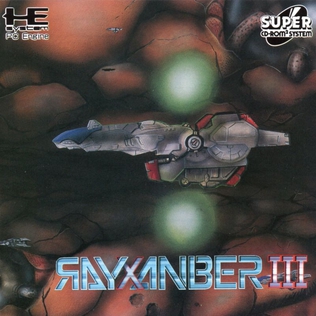
Rayxanber III is a 1992 scrolling shooter video game developed and published by Data West for the PC Engine Super CD-ROM². It is a follow-up to Rayxanber II, which was released earlier in 1991 for the PC Engine CD-ROM², and the last entry in the Rayxanber trilogy. In the game, the player assumes the role of a fighter pilot controlling a space craft deployed into the homeworld of the Zoul Empire, in retaliation for the destruction of a mother ship from Earth. It retains the same gameplay as its predecessors, with the players fighting against an assortment of enemy forces while avoiding collision with their projectiles and other obstacles.

Spriggan Mark 2: Re-Terraform Project is a 1992 horizontally scrolling shooter video game developed by Compile and published in Japan by Naxat Soft for the PC Engine Super CD-ROM². It is a follow-up to Seirei Senshi Spriggan (1991). The game follows lieutenant Greg Erwin piloting the armed Bartholomeu armor and later the Spriggan Mark 2 in a war between two opposing forces to decide the fate of a space colony at Mars. The player must fight against waves of enemies to avoid collision with their projectiles and other obstacles, while intermissions between characters during gameplay advances the storyline.

Sylphia is a 1993 vertically scrolling shooter video game developed by Compile and published in Japan by Tonkin House for the PC Engine Super CD-ROM². Whereas many shooting games of the era take place in a science fiction setting, this game instead mixes heroic fantasy and ancient Greek mythology. The game follows Silphia, a maiden warrior reincarnated as a demigoddess under Zeus after her demise in battle, facing against the forces of Hades.
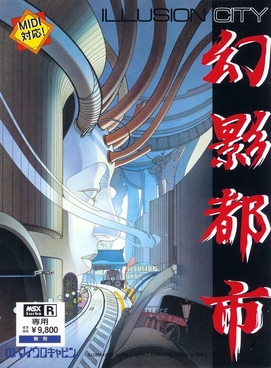
Illusion City is a role-playing video game originally developed and published by Microcabin for the MSX Turbo R home computer. It was later ported to PC-88 and PC-98 computers, FM Towns, X68000, and Sega Mega-CD. The story takes place in the 21st century after Hong Kong was devastated by a demonic attack, before the crisis was isolated and the region was reformed under new order by SIVA corporation. The game follows demon hunter Tianren, gathering information in order to unravel the mystery surrounding the demonic beings and SIVA corporation. Gameplay features a growing party led by Tianren navigating the city, talking with non-playable characters, exploring complex areas, and taking part in turn-based battles against enemies.




















